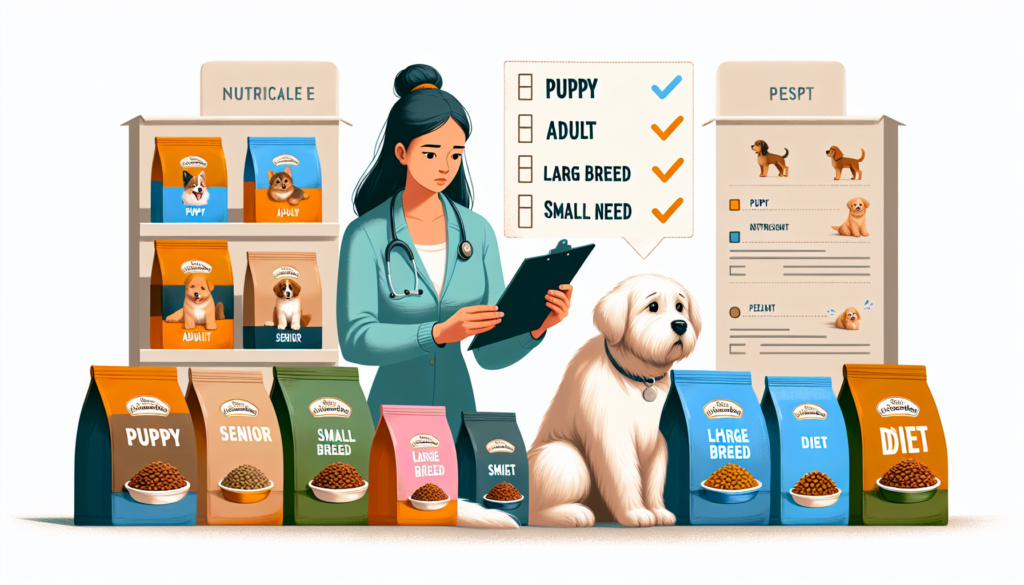How Do I Choose The Right Dog Food For My Pet?
You’ve just brought home a furry bundle of joy, and now, you’re faced with the important task of choosing the right dog food for your new companion. With countless options on the market, it’s easy to feel overwhelmed. But fear not! By understanding your dog’s specific nutritional needs and considering factors such as age, breed, and activity level, you can confidently navigate the world of dog food and provide your furry friend with the nourishment they need to thrive. So, let’s embark on this delightful journey together, and discover how to choose the perfect dog food for your beloved pet.

Determining your dog’s nutritional needs
When it comes to choosing the right dog food for your furry friend, it’s essential to consider their nutritional needs. Several factors play a significant role in determining what type of food will best suit your dog. These include their age, activity level, size, and breed.
Consider your dog’s age
Just like humans, dogs have different nutritional requirements at different stages of life. Puppies, for example, need a diet that supports their rapid growth and development. On the other hand, senior dogs may require food that caters to their changing needs and promotes joint health. Understanding your dog’s age-specific needs is crucial in selecting the right food to maintain their overall wellbeing.
Evaluate their activity level
Another vital aspect to consider when choosing your dog’s food is their activity level. Dogs with a high energy expenditure, such as those participating in agility training or working breeds, may benefit from foods formulated for active dogs. These foods often have higher protein and fat content to support their energy requirements. Conversely, dogs with a sedentary lifestyle may require a diet with lower calorie content to prevent excessive weight gain.
Take their size and breed into account
The size and breed of your dog can also influence their nutritional needs. Large-breed dogs, such as Great Danes or Mastiffs, have specific dietary requirements to support their bone and joint health. They may benefit from foods formulated with controlled calcium and phosphorus levels to prevent skeletal issues. Smaller breeds, on the other hand, may require smaller kibble sizes for ease of consumption.
Understanding the ingredients
The quality of ingredients in your dog’s food can greatly impact their overall health and wellbeing. It’s important to become familiar with the key components and make informed decisions regarding your dog’s dietary needs.
Look for specific meat sources
When assessing the ingredient list, make sure to prioritize foods that list specific meat sources, such as chicken, beef, or fish, as the primary ingredients. These sources are rich in protein, essential for your dog’s muscle development and overall health. Avoid generic terms like “meat” or “meat by-products,” as they provide little insight into the actual protein source.
Check for whole grains and vegetables
In addition to protein, your dog also requires a balanced diet that includes carbohydrates, fiber, and essential vitamins and minerals. Look for dog foods that contain whole grains like brown rice or oatmeal, as well as a variety of vegetables like sweet potatoes, peas, and carrots. These ingredients provide necessary energy and promote a healthy digestive system.
Avoid allergenic ingredients
Some dogs may have allergies or sensitivities to certain ingredients. Common allergens for dogs include wheat, corn, soy, and artificial additives. If you suspect your dog has a specific food allergy, consult your veterinarian for guidance on selecting a dog food that avoids these potential triggers.
Identifying the appropriate type of dog food
Once you’ve considered your dog’s nutritional needs and understand the importance of quality ingredients, it’s time to choose the appropriate type of dog food. There are three main categories to explore: dry dog food, wet or canned dog food, and semi-moist dog food.
Dry dog food
Dry dog food, also known as kibble, is the most commonly available and convenient option. It typically has a longer shelf life and is often more affordable compared to other types of dog food. Dry dog food is formulated to provide complete and balanced nutrition, making it suitable for many dogs. Additionally, the crunchy texture can help promote healthy teeth and gums.
Wet or canned dog food
Wet or canned dog food can be an excellent choice for dogs with poor appetite or dental issues. It provides higher moisture content than dry food, which can be particularly beneficial for dogs that struggle to stay hydrated. Canned dog food often contains more meat and may have a stronger flavor, making it more palatable for picky eaters.
Semi-moist dog food
Semi-moist dog food is a middle ground between dry and canned food. It typically comes in small, soft pellets or chewy pieces. This type of food is highly palatable, making it an excellent option for dogs who need a little extra encouragement to eat. However, it’s important to note that semi-moist dog food often contains higher levels of artificial flavors, colors, and preservatives, so it’s crucial to choose a reputable brand.
Considering special dietary requirements
Some dogs have specific dietary requirements that need to be addressed when selecting their food. This includes puppies, senior dogs, and dogs with allergies or sensitivities.
Food for puppies
Puppies require a nutrient-dense diet to support their rapid growth and development. Look for puppy-specific formulas that provide the essential building blocks for strong bones, healthy muscles, and a robust immune system. These diets often contain higher levels of protein, healthy fats, and DHA, a fatty acid crucial for brain development.
Senior dog food
As dogs age, their metabolism and activity levels tend to decrease, making weight management a priority. Senior dog food is formulated to meet the nutritional needs of older dogs, typically including lower calorie content and added joint support ingredients like glucosamine and chondroitin. These diets can help maintain mobility and support overall health in aging dogs.
Food for dogs with allergies
If your dog has allergies or sensitivities, it’s essential to find a food that avoids the specific allergens triggering their reactions. Limited ingredient diets or novel protein diets can be beneficial for these dogs. These diets typically contain a single source of novel protein, such as venison or duck, and exclude common allergenic ingredients like wheat, corn, or soy.
Evaluating the brand and manufacturer
Once you have narrowed down your options based on your dog’s nutritional needs and dietary requirements, it’s crucial to evaluate the brand and manufacturer.
Research the brand’s reputation
Do some research on the brand’s reputation and history. Look for companies that prioritize quality and transparency in their manufacturing processes. A reputable brand will often have a long-standing presence in the industry and prioritize the health and wellbeing of pets.
Read customer reviews
Customer reviews can provide valuable insights into the efficacy and palatability of a brand’s products. While individual experiences may vary, reading reviews can give you a better understanding of other pet owners’ experiences with the brand.
Consult your veterinarian
Your veterinarian is an invaluable resource when it comes to choosing the right dog food. They are familiar with your dog’s specific health needs and can provide personalized recommendations based on their expertise. Reach out to your vet and discuss your dog’s nutritional requirements and any concerns you may have before making a final decision.
Considering your budget
While your dog’s health should always be a top priority, it’s essential to find a dog food that fits within your budget. Here are a few tips to consider when evaluating the cost of different brands.
Compare prices among different brands
Take the time to compare prices among different brands while considering the quality and quantity of the food. Keep in mind that higher-priced options may not always equate to better quality, so it’s important to strike a balance between affordability and nutritional value.
Look for discounts and deals
Many pet food retailers offer discounts, promotions, or loyalty programs that can help you save money on your dog’s food. Keep an eye out for sales or bulk-buying options that can provide additional savings without compromising the nutritional value of the food.
Consider the long-term costs
While upfront costs are essential to consider, it’s also important to evaluate the long-term costs associated with a particular dog food. Some high-quality foods may require smaller serving sizes, meaning the bag will last longer, ultimately offsetting the initial price difference in the long run.
Taking your dog’s preferences into account
Just like humans, dogs have their preferences when it comes to food. While you ultimately make the final decision based on their nutritional needs, it’s essential to consider your dog’s preferences and any sensitivities they may have.
Observe your dog’s eating habits
Take note of your dog’s eating habits and preferences. Does your dog prefer a certain type of food or specific flavors? Do they have any difficulty chewing or digesting certain textures? Observing these patterns can help guide your decision-making process.
Experiment with different flavors and textures
If you find that your dog is not as enthusiastic about their current food, consider experimenting with different flavors or textures. Many brands offer a variety of options to cater to different taste preferences. However, be mindful of introducing new foods gradually to avoid digestive upset.
Consider any food sensitivities or aversions
If your dog has previously shown signs of food sensitivities or aversions, it’s crucial to take these into account when choosing their food. Opting for a limited ingredient diet or working with your veterinarian to identify potential triggers can help ensure your dog’s dietary needs are met without any adverse reactions.
Consulting your veterinarian
While researching and considering different factors is essential, nothing beats the expertise of your veterinarian when it comes to your dog’s health and nutrition.
Discuss your dog’s specific nutritional needs
Schedule an appointment with your veterinarian to discuss your dog’s specific nutritional needs. They can assess your dog’s overall health, provide guidance on nutrient requirements, and recommend specific brands or formulas that align with their dietary needs.
Ask for recommendations
Your veterinarian may have specific brand recommendations based on their experience and knowledge of your dog’s health history. They can provide insight into which foods have been effective in similar cases and recommend options that suit your dog’s preferences and health requirements.
Inquire about any health concerns
If your dog has any existing health concerns or underlying conditions, it’s crucial to share this information with your veterinarian. They can factor in any medical considerations when recommending a suitable dog food, ensuring it supports your dog’s overall health and wellness.
Reading and understanding pet food labels
Pet food labels can provide valuable information about the nutritional composition and quality of the food. Understanding how to read and interpret these labels can help you make informed decisions.
Identify the guaranteed analysis
The guaranteed analysis section on pet food labels provides information about the minimum or maximum levels of key nutrients such as protein, fat, fiber, and moisture. This information allows you to compare different brands and formulas to ensure they meet your dog’s specific nutritional requirements.
Understand the order of ingredients
The ingredient list on pet food labels is listed in descending order by weight. This means that the ingredients with higher percentages by weight are listed first. Pay attention to the first few ingredients, as they make up the majority of the food. If you’re looking for specific meat sources, ensure they are listed early in the ingredient list.
Look for nutritional adequacy statements
Nutritional adequacy statements on pet food labels indicate that the food meets the minimum nutritional requirements established by regulatory agencies. These statements often specify which life stage or lifestyle the food is suitable for, such as “complete and balanced for adult maintenance” or “formulated for puppies.” Choosing a food with appropriate adequacy statements ensures your dog receives the necessary nutrients for their specific life stage or needs.
Monitoring your dog’s response to the chosen food
After selecting a dog food that meets your dog’s nutritional needs, it’s important to monitor their response to ensure it’s the right fit for them.
Observe their energy levels and coat condition
A quality dog food should provide your dog with the necessary energy to maintain an active and healthy lifestyle. Monitor your dog’s energy levels, looking for signs of increased vitality or undesirable lethargy. Additionally, assess their coat condition for its shine, overall health, and reduced shedding.
Assess their digestion and stool quality
Your dog’s digestion and stool quality can indicate if their current food agrees with them. Look for consistent firmness, regular bowel movements, and minimal digestive issues like gas or diarrhea. If you notice any significant changes in digestion or stool quality, it may be necessary to re-evaluate their diet.
Monitor any changes in weight or overall health
Regularly weigh your dog and monitor their weight. An appropriate diet should help them maintain a healthy weight, avoiding both excessive weight gain and weight loss. Additionally, keep an eye out for any changes in your dog’s overall health, such as changes in skin or coat condition, increased thirst, or any abnormal behaviors. Promptly consult with your veterinarian if you notice any concerning changes.
By considering your dog’s age, activity level, size and breed, understanding the ingredients, identifying the appropriate type of dog food, considering special dietary requirements, evaluating the brand and manufacturer, taking your dog’s preferences into account, consulting your veterinarian, reading and understanding pet food labels, and monitoring your dog’s response to the chosen food, you will be well-equipped to choose the right dog food for your beloved pet. Remember, providing a balanced and nutritious diet is a crucial aspect of ensuring your dog’s overall health and happiness.







